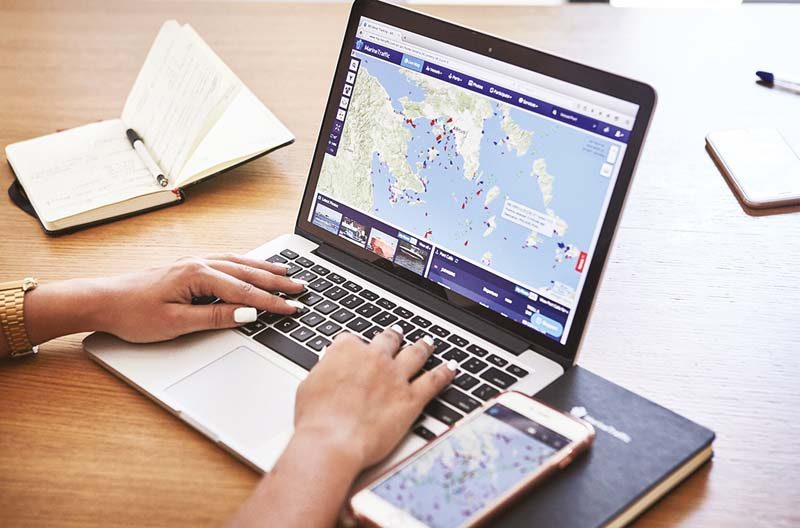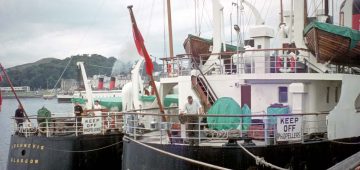By Paul Gonzales Morgan

Argyris Stasinakis is Partner, Board Member and responsible for Business Development at Marine Traffic, the Global pioneer in AIS vessel tracking. Founded in 2007 as an experiment, it now counts with a wide range of driven professionals with a common goal: to make the shipping industry more efficient and transparent.

Please talk to us about your main responsibilities as a Board Member of MarineTraffic:
I am one of three partners in the business and my main responsibilities lie in the strategic corporate growth of MarineTraffic. We are a fast-growing maritime intelligence business used by a wide range of companies and organisations and our services allow for intelligence-led decisions. An important part of my work is forging partnerships and developing growth strategies which optimally place our business to leverage and contribute towards the undergoing digital transformation of the maritime industry.
Please tell us more about your company’s vision and team:
The MarineTraffic success story is based on people. From our Athens, Oxford and recently opened Singapore offices, a team of talented programmers, data curators and customer services people in the business have built a data-driven vessel tracking service that is used by 6.5 million people a month. But our accomplishments are not just down to MarineTraffic employees: it is our huge global network of AIS station managers (in excess of 3,000 active coastal receivers) and photographers (in excess of 2 million photos) who have enabled MarineTraffic to be such a success.
Our vision is to become more deeply embedded than ever before in our professional customers’ businesses. The first step is to move even deeper into optimising ship voyages. We want to be more closely involved with how a ship interacts with a terminal, including planning and execution of nautical services. We adopt a holistic approach of optimising the voyage from berth to berth, going beyond standard routeing services which are currently available. Benefits are significant: lower fuel consumption, lower emissions, improved berth occupancy, tighter time windows for delivery of services. The overall financial and environmental impact concerns individual stakeholders and society in general.
The second step is to build on MarineTraffic reach and provide digital space to allow other enterprises to do business on the MarineTraffic platform, as well as supporting a range of projects and enterprises. We want to turn MarineTraffic into a global platform for the shipping industry. We envisage the MarineTraffic screen at the heart of a range of maritime transactions. Whilst MarineTraffic has long been facilitating API data exchange, by allowing third parties to build their own systems incorporating MarineTraffic data, the future will see a marketplace approach with a seamless experience for our users. Key features will be interaction between users across organisations, collaborating on processes involving multiple parties.
What competitive advantage do you have over other ship tracking services in the market?
At base level, the quality of our data and reach is second to none. Our reach is wider than any other tracking service and critically our freemium service is easy to use. One step further, we are thought leaders in data advancements in the maritime domain, combining deep knowledge, a thirst for innovation, a high degree of realism and constant interaction/feedback from our clients. I believe our approach is unique.
Public tracking of ships can be a challenge in those areas with high risk of piracy. How does this work?

Any ship transiting an area at risk of piracy has the ability to switch off their AIS. It is a decision for the ship’s Master. AIS is not an enabler or cause of piracy.
How does Marine Traffic contribute to safety at sea?
MarineTraffic is not a safety system and we do not recommend that anyone uses our system as a navigational aid. Having said that, our historical data is frequently used in studying patterns of life, traffic density in sensitive areas (e.g. ports, canals, wind farms, floating platforms…), accidents etc. Our video playback feature is an excellent tool for visualising events over a time window in a specific area. Such data and tools enables authorities to revise local regulations as necessary, enhancing, in a preemptive fashion, safety of life at sea.
What are your views on autonomous ships?
As a technical, IT orientated person I am of course intrigued by the concept of autonomous ships. There are some extremely exciting and interesting projects in this area. I can see how many of the activities carried out by seafarers could be automated, allowing sea staff to focus on the aspects of bridge and engine room management that require problem-solving skills and creativity. However, we are still some way off from the day of the fully autonomous ship.
How do you see new technology improving future tracking services?
The proliferation of satellite broadband services already has a positive impact on data collected from ships. This applies to position tracking data with the caveat that such data is, of course, proprietary. AIS, which we capture, is an open transmission, available to all. The technology is already 20+ years old, which is “old” in our fast moving world. In the short-mid term, we expect improved coverage thanks to floating (“roaming”) AIS receivers on board vessels and to new, larger constellations of satellites capturing the AIS signal.
What other less popular applications do you provide users, apart from standard vessel tracking?
We are proud of our new business directory. It is growing in popularity, since businesses choose to register with MarineTraffic. We welcome them all, there is no cost involved. Importantly, enhanced visibility via promotion packages is available. We consider this an important development. MarineTraffic has always been about ships and ports and is now encompassing businesses and professionals.
This is a trusted service enhancing visibility of companies and their work. We focus on detail, running pilots with several regional and global companies and we look for more!
Where do you see your company in 5 years from now?
I see MarineTraffic as increasingly embedded in the day to day life of the shipping and supply chain professional. There is a strong alignment within the MarineTraffic leadership team and we are highly active within global alliances. We see a space full of opportunities
Please tell us about your memorable shipping experience and favourite ship:
My background is in data and information technology, so I have mostly experienced shipping as a passenger. I remember as a child grasping my glasses so that they do not fall off my head at sea as I was staring at the reflection of the sun. I remember, at a later age, dolphins while travelling (on the El Venizelos, I believe) in the Aegean towards Crete. And I later remember partying on a cruise ship while crossing the Adriatic. Good memories all of them. You know, when visiting ports, I somehow still have this fleeting desire to board a ship and just go anywhere it takes me!





Comments
Sorry, comments are closed for this item